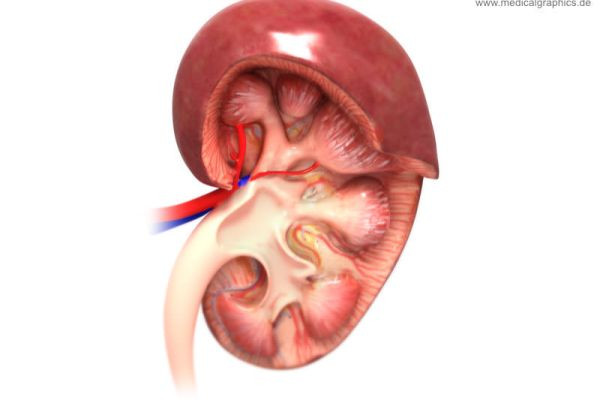Excretory System
The excretory system includes 5 major constituent organs that remove metabolic waste through various components including the kidney, ureter, urinary bladder, and urethra.
Excretory System Definition
Excretion is the body’s process through which waste materials are removed. The body metabolizes the food that we consume for various processes. After the breakdown of fats, proteins, sugars, and other nutrients, the cells send the waste products for removal.
The excretory system then removes the metabolic waste through various components, including the kidneys, liver, lungs, and skin. For the scope of this article, the focus is on the excretory system in human; the kidneys and the urinary system are emphasized.
What is Excretion?
Excretion is the biological process of removing excess waste and water from the body. By removing the metabolic waste, the excretory system in human beings maintains homeostasis. While kidneys form the major part of the excretory system, several other organs are also involved in excretory activity, such as the liver, skin, large intestine, and lungs.
Functions of Excretory System?
The excretory system removes solid, liquid, and gaseous waste in the way as summarized below:
- The water vapor and carbon dioxide waste are exhaled through the lungs.
- The liver breaks down several toxic substances present in the blood, along with excess amino acids.
- The skin also acts as the excretory system in humans by removing excess salts and water.
- The kidneys filter out the blood and remove most of the metabolic waste produced in the body, including hormones and ionic salts.
- The large intestine eliminates the waste products left over after digestion.
What are the Parts of the Human Excretory System?
The excretory system parts consist of these four main units:
- A pair of kidneys
- A pair of ureters
- A urinary bladder
- A urethra
Kidneys
- Kidneys are the main organs of the excretory system in human beings where filtration, selective reabsorption, and urine production occurs.
- They are dark, bean-shaped organs that measure 10cm long and 6cm wide.
- The kidneys contain nephrons which perform the filtration of blood within the organ.
Ureters
The ureters are tube-like structures that carry urine from the kidneys to the urinary bladder. The ureters connect the kidneys to the urinary bladder.
Urinary Bladder
The urinary bladder is a muscular sac-like structure that can expand and contract to accommodate urine. The opening of the urinary bladder is controlled by a muscular sphincter that opens during urination.
Urethra
The urethra is a short, muscular tube through which the urine is expelled out.
##Mechanism of Excretion in Humans Here is the mechanism of excretion in humans -
Glomerular Filtration
This is the initial stage in this. The waste products and extra fluids are filtered out into the urine collection tubules and eliminated from the body.
Tubular Reabsorption
Here, the molecules like sodium ions, amino acids, water, glucose, etc are absorbed. Sodium ions and glucose are absorbed through active processes and water through passive absorption.
Secretion
Hydrogen ions, ammonia, and potassium ions are secreted to manage the equilibrium of body fluids. Potassium ions, hydrogen ions, and ammonia are secreted out to maintain the equilibrium between the body fluids.
Micturition
In this step, the urinary bladder is stretched and the urine gets filled. The urinary bladder wall contains receptors that send signals to the CNS(Central Nervous System) and allow the sphincter muscle to relax to release urine.
Human Urine Excretion
Human urine excretion process is all about nephrons and it leads to renal corpuscle, Bowman’s capsule, Proximal Convoluted Tubule, Loop of Henle, Distal Convoluted Tubule, Juxtaglomerular Apparatus, Collecting ducts, Renal Pelvis and Ureter, Urinary bladder, and Urethra.
Nephron
It is the functional and structural unit of the kidney. Nephron contains 4 components - ● Renal corpuscle ● Proximal convoluted tubule ● Loop of Henle ● Distal convoluted tubule
Renal Corpuscle
It is responsible for filtering plasma. It has 2 structures- Glomerulus and Bowman’s capsule. The glomerulus is a group of capillary loops that are enclosed by Bowman’s capsule.
Bowman’s Capsule
It surrounds the glomerular capillary loops. Moreover, it also participates in the filtration process of blood from these glomerular capillaries. Additionally, Bowman’s capsule has a structural function and male urinary space via which the filtrate could enter the nephron and go to proximal convoluted tubule.
Proximal Convoluted Tubule
They reabsorb the nutrients, ions, and water. Moreover, they also remove the toxins and maintain the pH and ionic balance by secreting hydrogen, ammonia, and potassium.
Loop of Henle
● Loop of Henle (Descending) - It is permeable to water. Moreover, the filtrate is concentrated. This is because it is impermeable to electrolytes. ● Loop of Henle (Ascending) - It is impermeable to water. Additionally, it is permeable to electrolytes. The present filtrate is diluted because of the electrolytes movement.
Distal Convoluted Tubule
It allows the reabsorption of sodium ions and water. Also, it helps to maintain ionic balance and pH by secretion.
Juxtaglomerular Apparatus
It has the main function of secreting the renin, that regularises the blood pressure through the renin-angiotensin-aldosterone system.
Collecting Ducts
It reabsorbed huge amounts of water from the filtrate.
Renal Pelvis and Ureter
Multiple collecting ducts merge into the renal pelvis, which then turns into the ureter. It is a muscular tube, That has an internal longitudinal layer and an outer circular layer. The lumen is protected with the aid of using transitional epithelium.
Urinary Bladder
Here, the urine is emptied. The transitional epithelium keeps over the surface of this organ. The muscular layers turn out to be interwoven and can't be genuinely diagnosed at this point.
Urethra
The urethra incorporates the urine away from the bladder to the outside of the body. In the male, it is joined through the genital system. The epithelium modifications from transitional to stratified columnar in the urethra, and to stratified squamous withinside the distal end of the urethra.
Other Excretory Organs
Skin
The skin is a part of the integumentary system, however it additionally performs a role in excretion via the production of sweat through sweat glands in the dermis. Although the primary role of sweat production is to chill the body and hold temperature homeostasis, sweating additionally gets rid of extra water and salts, as well as a small quantity of urea.
Lungs
The lungs are a part of the respiratory system, however they're additionally vital organs of excretion. They are accountable for the excretion of gaseous wastes. The primary waste gas excreted through the lungs is carbon dioxide, that's a waste product of cellular respiration in cells. Carbon dioxide is subtle from the blood into the air in the small air sacs called alveoli.
By expelling CO2 from the blood, the lungs assist maintain acid-base homeostasis. In fact, it's the pH of blood that controls the breathing rate. Water vapour is lifted up from the lungs and different organs of the breathing tract because the exhaled air passes over their wet linings, and the water vapour is excreted together with the carbon dioxide.
Liver
The liver has various fundamental functions, which include secreting bile , storing glycogen, synthesising many proteins and different compounds, and secreting endocrine hormones.
Additionally, the liver is a completely vital organ of excretion. The liver breaks down many materials in the blood, along with toxins. For example, the liver transforms ammonia into urea, which is filtered from the blood through the kidneys and excreted in urine.
Excretory System Facts
● The urinary bladder of the human excretory system can hold around 600 ml of liquid. Oroever, during the early stage of pregnancy, the uterus is pressed on the bladder. It creates a better frequency of urine. ● Majority of amniotic fluid that surrounds the foetus is foetal urine. However, most of the composition is very unique from usual urine. ● The foetal urine is very important for the foetal lungs development.
Conclusion
- The human excretory system comprises the kidneys, ureters, urinary bladder, and urethra.
- It removes the waste products of cellular metabolism, maintains salt-water balance, and filters out toxins from the body.
FAQs
1. What is the excretory system and its function?
The excretory system of the body performs the task of excreting the waste produced after cellular metabolic processes.
2. What are the four excretory systems?
The excretory system in human beings includes the organs such as kidneys, lungs, liver, and skin.
3. Where is the excretory system in the body?
The main excretory system, which is the urinary system, is located in the lower abdomen.
4. What are the parts of the excretory system?
The main parts of the excretory system are the kidneys, ureters, urinary bladder, and urethra.
5. What are the three main functions of the excretory system?
The three main functions of the excretory are filtration, reabsorption, and production of urine.
6. What are the 7 functions of the kidney?
The 7 main functions of the kidney are:
- Controlling water balance
- Maintaining electrolyte balance
- Maintaining acid-base balance
- Removing waste products and toxins from the body
- Controlling blood pressure
- Secreting the hormone erythropoietin
- Vitamin D activation
7. What are some examples of the excretory system?
Some of the examples of the excretory system include:
- Filtration of blood by the urinary system
- Exhalation of carbon dioxide from lungs
- Elimination of salt and fluids through the skin
8. What are the functions of the nephron?
The nephron is the basic unit of the kidney which regulates the solutes in the blood. It filters the blood and selectively reabsorbs what is necessary, and discards the rest as urine.
9. What is the importance of the excretory system?
The excretory system maintains homeostasis by regulating water and electrolyte balance and eliminating metabolic waste.
We hope you enjoyed studying this lesson and learned something cool about the Excretory System! Join our Discord community to get any questions you may have answered and to engage with other students just like you! Don't forget to download our App to experience our fun, VR classrooms - we promise, it makes studying much more fun!?







